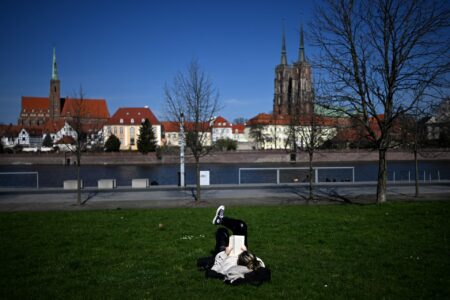
Austria has become a popular international student hub — for good reasons. Located in Central Europe, the country ranks 16th in this year’s Best Student Cities ranking. Pair that with an estimated living cost of 1,200 euros (US$1,315), and it’s little surprise why many choose to study in Austria.
Tuition fees in Austrian universities are cheap, too.
Like most European countries, Austrian students, nationals of the European Union (EU), and European Economic Area (EEA) member countries generally do not pay tuition fees at public universities until they go over the allocated duration of their programme. Even then, there’s still a “tolerance” of two semesters provided before fees must be paid.
On top of that, all students, regardless of nationality, must pay 24.70 euros (US$28.17) per semester, which covers the student union membership fee and accident insurance.
The catch? Most Austrian universities will require you to have a certain degree of German proficiency — so be prepared to factor in an additional year of language learning before you take advantage of the country’s affordable educational offerings.
Study in Austria: Cheapest universities for international students
1. The University of Vienna
The University of Vienna is known as one of the oldest universities in Europe. It is located in the heart of the city of Vienna and is the country’s best-ranked higher education institution, according to the QS World University Rankings 2025.
At its core, the university promotes diversity through research. There’s something for everyone here, including over 50 undergraduate programmes and more than 100 postgraduate ones. The university’s ranking by subjects has been steadily climbing up the ranks too — as of 2025, they rank #15 for communication and media studies and #29 for theology, divinity, and religious studies.
German knowledge on the C1 level is an admission requirement for all bachelor and diploma programmes. Most undergraduate and certain postgraduate programmes are taught in German, though a handful of master’s degrees are conducted in English.
Tuition for students who are citizens of the EU or EEA countries is 363.36 euros (US$398) per semester, while non-citizens pay 726.72 euros (US$796) per semester.
View this post on Instagram
2. University of Salzburg
Nestled in architecturally breathtaking buildings in Salzburg’s city centre, the University of Salzburg — also known as Paris Lodron University Salzburg — is Salzburg’s largest educational institution.
The university is home to six faculties, including the Faculty of Catholic Theology, Faculty of Cultural Sciences, Faculty of Digital and Analytical Sciences, Faculty of Law, Business and Economics, Faculty of Natural and Life Sciences, and Faculty of Social Sciences. It also offers a comprehensive teacher’s training programme where students can combine a range of 26 subjects.
Most bachelor’s programmes here require a German language proficiency of at least B2. Some of the master’s programmes, like Data Science, Medical Biology, and Political Science, are taught in English, while most of the others are conducted in German.
EU and EEA students going beyond the designated duration of the programme pay fees of 363.36 euros (US$398) per semester. Non-EU and EEA students pay 726.72 euros (US$796) per semester.

Beyond getting a world-class education while you study in Austria, you’ll also be able to witness and experience its various picturesque landscapes. Source: AFP
3. Johannes Kepler University Linz
Johannes Kepler University Linz (JKU) — formerly known as the University of Social and Economic Sciences — is one of Austria’s younger universities. Situated in Linz, the third largest city in Austria, JKU sets itself apart by having all its teaching in one location.
The university has four faculties (Engineering and Natural Sciences, Business and Social Sciences, Law, and Medicine) across six schools (Linz Institute of Technology, Linz School of Education, Business School, Kurt Rothschild School of Economics and Statistics, Linz Institute for Transformative Change, and School of Social Sciences and Humanities).
JKU is one of the places you can study in Austria in English. Here, they offer a range of English-taught programmes and dual-language degree programmes that are generally offered in German.
EU and EEA students who go beyond their designated programme duration will need to pay 363.36 euros (US$398) per semester. Other international students pay a fee of 726.72 euros (US$796) per semester.
4. Technische Universität Wien
Technische Universität Wien, commonly known as TU Wien, is Austria’s second-best university, ranking #190 in the QS World University Rankings 2025. The university has a long history, especially as the first University of Technology in present-day German-speaking Europe.
As a university conducting research, teaching and learning under the motto “Technology for people,” the school’s best-ranked programmes are in the subjects of architecture and built environment and computer science and information systems.
Do note that the bachelor’s programmes at TU Wien are generally delivered in German, so you have to prove sufficient knowledge of the language to be admitted into the degree programme. Fortunately, most of their master’s programmes are delivered in English.
EU and EEA students who go beyond their designated programme duration will need to pay 363.36 euros (US$398) per semester. International students from other countries pay a fee of 726.72 euros (US$796) per semester.
View this post on Instagram
5. Academy of Fine Arts Vienna
For those inclined towards the arts, the Academy of Fine Arts Vienna places a particular emphasis on arts-based research and teaching. The academy’s offerings span painting and sculpture to photography, video, performance, and conceptual art, as well as architecture, stage design, conservation, and restoration.
While the academy only boasts a student body of around 1,500 students, it has turned this into a strength with the international reputation of its teaching staff and the diversity of its students, who come to Vienna from over 50 countries. Beyond that, the academy actively collaborates worldwide with other universities as well as with art and cultural institutions, and encourages and supports its students to gain international experience as part of their studies.
Having at least a German language proficiency skill at B2 will be ideal as most of the programmes here have that requirement.
EU and EEA students who go beyond their designated programme duration pay 363.36 euros (US$398) per semester. International students, on the other hand, pay a fee of 726.72 euros (US$796) per semester.
View this post on Instagram
6. University for Continuing Education Krems
Working professionals seeking to upscale themselves while studying in Austria consider the University for Continuing Education Kerms — previously known as Danube University Krems. Here, the average age of students is 39, and the international student body is made up of those from 99 different countries.
The university consists of three faculties: Health and Medicine, Business and Globalisation, and Education, Arts and Architecture. The study model here is oriented toward the specific requirements of adult learners in all phases of life and especially to the needs of working professionals.
Most of the programmes here are conducted in German.
Locals and EU residents can study for free. For international students, tuition fees start from US$422 per year.
7. BOKU University
If you’re interested in agriculture and specialising and hope to study in Austria, then BOKU University is the place to be. Having started in 1872 as a small university with those subject specialities, it is now one of the most modern life sciences universities in Europe.
All of BOKU’s undergraduate programmes are taught in German. They offer German-taught master’s programmes too, but have a range of English-taught options as well, including but not limited to Biotechnology, Mountain Forestry, and Green Chemistry.
EU and EEA students going beyond the designated duration of the programme pay fees of 363.36 euros (US$398) per semester. Non-EU and EEA students pay 726.72 euros (US$796) per semester.

When you study in Austria, you get the chance to enjoy the sights and experiences, like its Christmas markets. Source: AFP
8. University of Klagenfurt
Located in Carinthia, the University of Klagenfurt is the largest academic institution and a hub for the whole of the Alps-Adriatic region in terms of knowledge acquisition, exchange, and transfer. You’ll find around 20% of international students coming from 100 countries in the university’s four faculties — Arts, Humanities & Education, Management, Economics & Law, Social Sciences, and Technical Sciences — and 33 departments.
The university offers a selection of English-taught undergraduate and postgraduate programmes. Meanwhile, it’s recommended you have at least a B2 in German language proficiency if you choose to pursue a programme in the language.
EU and EEA students who go beyond their designated programme duration will need to pay 363.36 euros (US$398) per semester. International students from other countries pay a fee of 726.72 euros (US$796) per semester.
9. Technische Universität Graz (TU Graz)
Technische Universität Graz (TU Graz) is one of the most affordable universities in Austria.
It ranks among the top 413 universities globally in the QS World University Rankings 2025 and is recognised for its strong focus on engineering, technology, and innovation.
What makes TU Graz stand out is how practical and hands-on the learning is. Students get to work on real projects, use state-of-the-art labs, and even collaborate with top industry partners. By the time you graduate, you will already have valuable experience.
The tuition fees for EU students are around 363.36 euros (US$424.01), while non-EU students pay around 726.72 euros (US$847.98) per semester, which is more affordable compared to most other countries.
Disclaimer: This article was last updated on October 15, 2025.











